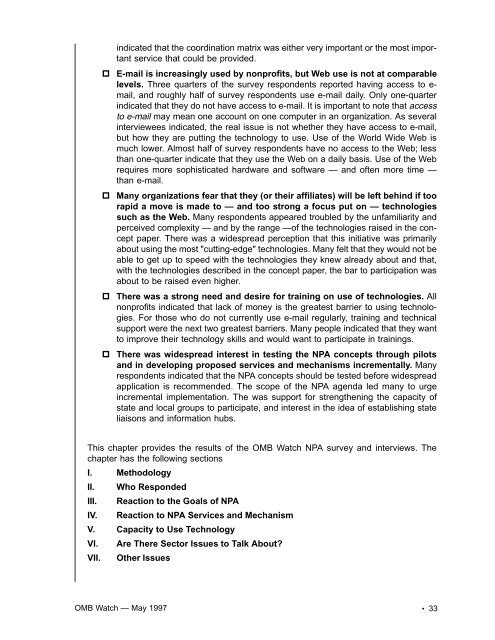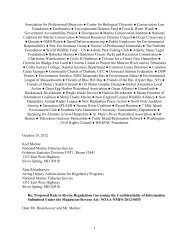About OMB Watch
Chapter III Technology Advisory Committee - OMB Watch
Chapter III Technology Advisory Committee - OMB Watch
- No tags were found...
You also want an ePaper? Increase the reach of your titles
YUMPU automatically turns print PDFs into web optimized ePapers that Google loves.
indicated that the coordination matrix was either very important or the most important<br />
service that could be provided.<br />
p E-mail is increasingly used by nonprofits, but Web use is not at comparable<br />
levels. Three quarters of the survey respondents reported having access to e-<br />
mail, and roughly half of survey respondents use e-mail daily. Only one-quarter<br />
indicated that they do not have access to e-mail. It is important to note that access<br />
to e-mail may mean one account on one computer in an organization. As several<br />
interviewees indicated, the real issue is not whether they have access to e-mail,<br />
but how they are putting the technology to use. Use of the World Wide Web is<br />
much lower. Almost half of survey respondents have no access to the Web; less<br />
than one-quarter indicate that they use the Web on a daily basis. Use of the Web<br />
requires more sophisticated hardware and software — and often more time —<br />
than e-mail.<br />
p Many organizations fear that they (or their affiliates) will be left behind if too<br />
rapid a move is made to — and too strong a focus put on — technologies<br />
such as the Web. Many respondents appeared troubled by the unfamiliarity and<br />
perceived complexity — and by the range —of the technologies raised in the concept<br />
paper. There was a widespread perception that this initiative was primarily<br />
about using the most "cutting-edge" technologies. Many felt that they would not be<br />
able to get up to speed with the technologies they knew already about and that,<br />
with the technologies described in the concept paper, the bar to participation was<br />
about to be raised even higher.<br />
p There was a strong need and desire for training on use of technologies. All<br />
nonprofits indicated that lack of money is the greatest barrier to using technologies.<br />
For those who do not currently use e-mail regularly, training and technical<br />
support were the next two greatest barriers. Many people indicated that they want<br />
to improve their technology skills and would want to participate in trainings.<br />
p There was widespread interest in testing the NPA concepts through pilots<br />
and in developing proposed services and mechanisms incrementally. Many<br />
respondents indicated that the NPA concepts should be tested before widespread<br />
application is recommended. The scope of the NPA agenda led many to urge<br />
incremental implementation. The was support for strengthening the capacity of<br />
state and local groups to participate, and interest in the idea of establishing state<br />
liaisons and information hubs.<br />
This chapter provides the results of the <strong>OMB</strong> <strong>Watch</strong> NPA survey and interviews. The<br />
chapter has the following sections<br />
I. Methodology<br />
II. Who Responded<br />
III. Reaction to the Goals of NPA<br />
IV. Reaction to NPA Services and Mechanism<br />
V. Capacity to Use Technology<br />
VI. Are There Sector Issues to Talk <strong>About</strong>?<br />
VII. Other Issues<br />
<strong>OMB</strong> <strong>Watch</strong> — May 1997<br />
• 33



